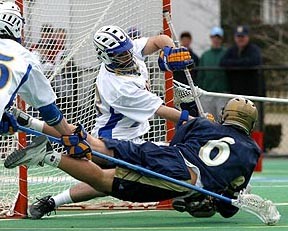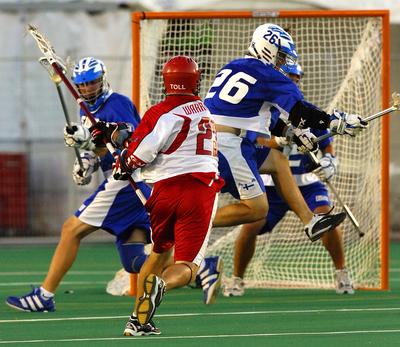 |
 |
||||||||
Lacrosse RulesThe Rules of LacrosseMen's Lacrosse Rules Men's lacrosse is a contact game played by ten players: a goalie, three defensemen, three midfielders and three attackmen. The object of the game is to shoot the ball into the opponent's goal. The team scoring the most goals wins. Each team must keep at least four players, including the goalie, in its defensive half of the field and three in its offensive half. Three players (midfielders) may roam the entire field. Collegiate games are 60 minutes long, with 15-minute quarters. Generally, high school games are 48 minutes long, with 12-minute quarters. Likewise, youth games are 32 minutes long, with eight-minute quarters. Each team is given a two-minute break between the first and second quarters, and the third and fourth quarters. Halftime is ten minutes long. Teams change sides between periods. Each team is permitted two timeouts each half. The team winning the coin toss chooses the end of the field it wants to defend first. 
The lacrosse rules say that players take their positions on the field: four in the defensive clearing area, one at the center, two in the wing areas and three in their attack goal area. Men's lacrosse begins with a face-off. The ball is placed between the sticks of two squatting players at the center of the field. The official blows the whistle to begin play. Each face-off player tries to control the ball. The rules of lacrosse state that players in the wing areas can run after the ball when the whistle sounds. The other players must wait until one player has gained possession of the ball, or the ball has crossed a goal area line, before they can release. Center face-offs are also used at the start of each quarter and after a goal is scored. Field players must use their crosses to pass, catch and run with the ball. Only the goalkeeper may touch the ball with his hands. A player may gain possession of the ball by dislodging it from an opponent's crosse with a stick check. A stick check is the controlled poking and slapping of the stick and gloved hands of the player in possession of the ball. Body checking is permitted if the opponent has the ball or is within five yards of a loose ball. All body contact must occur from the front or side, above the waist and below the shoulders, and with both hands on the stick. An opponent's crosse may also be stick checked if it is within five yards of a loose ball or ball in the air. Aggressive body checking is discouraged. Lacrosse rules state that if the ball or a player in possession of the ball goes out of bounds, the other team is awarded possession. If the ball goes out of bounds after an unsuccessful shot, the player nearest to the ball when and where it goes out of bounds is awarded possession. An attacking player cannot enter the crease around the goal, but may reach in with his stick to scoop a loose ball. A referee, umpire and field judge supervise field play. A chief bench official, timekeepers and scorers assist. Men's Lacrosse Rules | Personal and Technical FoulsThere are personal fouls and technical fouls in boy's lacrosse. The penalty for a personal foul results in a one to three minute suspension from play and possession to the team that was fouled. Players with five personal fouls are ejected from the game. The penalty for a technical foul is a thirty-second suspension if a team is in possession of the ball when the foul is committed, or possession of the ball to the team that was fouled if there was no possession when the foul was committed. Note: The US Lacrosse Youth Council has developed modified lacrosse rules for ages 15 and under play. To get a copy of these rules contact US Lacrosse at 410.235.6882. Personal Fouls1)Slashing: Occurs when a player's stick viciously contacts an opponent in any area other than the stick or gloved hand on the stick. 2)Tripping: Occurs when a player obstructs his opponent at or below the waist with the crosse, hands, arms, feet or legs. 3)Cross Checking: Occurs when a player uses the handle of his crosse between his hands to make contact with an opponent. 4)Unsportsmanlike Conduct: Lacrosse rules say that this occurs when any player or coach commits an act which is considered unsportsmanlike by an official, including taunting, arguing, or obscene language or gestures. 5)Unnecessary Roughness: Occurs when a player strikes an opponent with his stick or body using excessive or violent force. 6)Illegal Crosse: Occurs when a player uses a crosse that does not conform to required specifications. A crosse may be found illegal if the pocket is too deep or if any other part of the crosse was altered to gain an advantage. 7)Illegal Body Checking: Occurs when any of the following actions takes place:
8)Illegal Gloves: The rules of lacrosse say that this occurs when a player uses gloves that do not conform to required specifications. A glove will be found illegal if the fingers and palms are cut out of the gloves, or if the glove has been altered in a way that compromises its protective features. Technical Fouls1)Holding: Occurs when a player impedes the movement of an opponent or an opponent's crosse. 2)Interference: Occurs when a player interferes in any manner with the free movement of an opponent, except when that opponent has possession of the ball, the ball is in flight and within five yards of the player, or both players are within five yards of a loose ball. 3)Offsides: Lacrosse rules states that this occurs when a team does not have at least four players on its defensive side of the midfield line or at least three players on its offensive side of the midfield line. 4)Pushing: Occurs when a player thrusts or shoves a player from behind. 5)Screening: Occurs when an offensive player moves into and makes contact with a defensive player with the purpose of blocking him from the man he is defending. 6)Stalling: Occurs when a team intentionally holds the ball, without conducting normal offensive play, with the intent of running time off the clock. 7)Warding Off: The rules of lacrosse says that this occurs when a player in possession of the ball uses his free hand or arm to hold, push or control the direction of an opponent's stick check. All of these lacrosse rules were brought to you by USLacrosse.org.
|
Find a topic...
***JustLaxin.shtml***
***footer.shtml***
|
| |||||||